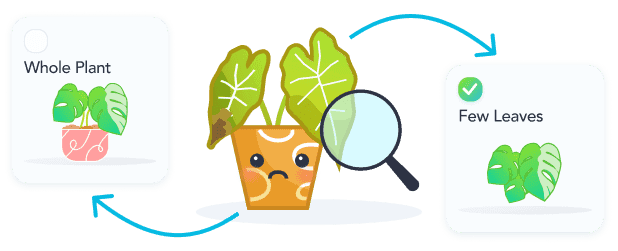Every 14d
Recommended Frequency
1 /2 cup of water
Recommended Amount
String of Turtles don't require much water. When the top two-three inches of soil are dry to the touch, it's time to water your plant.
Every 14d
Recommended Frequency
Fertilize your String of Turtles every two weeks during spring or summer using a cactus fertilizer diluted by half.
Indirect Sun
Recommended
Indirect Sun or Filtered Sun is when sun exposure is being filtered through a sheer curtain or is not able to have the sun's rays directly hit the leaves/flowers of your plant.
Every 730d
Recommended Frequency
Repot your String of Turtles every two years, or once it outgrows its pot.
Sandy Soil
Recommended Soil
Peat Soil is an acidic soil that retains a lot of moisture and slows decomposition. Due to such a high moisture retention this mix may require irrigation to help with draining. This soil type is best used when paired wit...
The String of Turtles plant thrives in environments with humidity levels around 60%, which falls into the average to high humidity range. This level of moisture in the air is crucial for maintaining the plant's vibrant p...

Shop String of Turtles
Questions about String of Turtles
The String of Turtles plant, scientifically known as Peperomia prostrata, is a popular houseplant cherished for its unique, turtle shell-like leaf patterns. Native to the Brazilian rainforest, this trailing vine thrives ...

Toxicity of String of Turtles

Common Pests and Diseases
Root Rot
Overwatering
To address root rot in String of Turtles, first, cease watering immediately and allow the soil to dry out. If the plant is severely affected, remove it from its pot, trim away any black, mushy roots, and repot in fresh, well-draining soil. Ensure the pot has adequate drainage holes. Going forward, water only when the top inch of soil feels dry to the touch, and avoid letting the plant sit in water.
Leaf Shriveling
Underwatering
To address leaf shriveling due to underwatering in String of Turtles, ensure a consistent watering schedule that keeps the soil lightly moist but not waterlogged. Allow the top inch of soil to dry out between waterings. Consider using a pot with good drainage and a well-draining potting mix to prevent water retention. If the plant has been severely underwatered, gradually reintroduce water to avoid shock. Monitoring the plant's response to watering adjustments is crucial for recovery.
Mealybugs Infestation
Mealybugs are small, white, soft-bodied insects that feed on the sap of the string of turtles, weakening the plant and causing stunted growth.
To combat mealybugs, start by isolating the affected plant to prevent the spread to others. Use a cotton swab dipped in rubbing alcohol to dab directly onto the pests, effectively killing them without harming the plant. For larger infestations, rinse the plant gently with water to remove any visible pests, then apply neem oil or insecticidal soap to the plant, following the product's instructions. Repeat the treatment every 7-10 days until the infestation is cleared. Regularly check the plant for any signs of return.
Leaf Yellowing and Drop
Insufficient Light
String of turtles thrives in bright, indirect light. If you notice yellowing leaves or leaf drop, it's likely due to insufficient light. To remedy this, gradually move your plant closer to a light source, but avoid direct sunlight which can scorch the leaves. Consider using a grow light during winter months or in rooms with poor natural lighting. Regularly rotating the plant can also ensure all sides receive adequate light, promoting even growth and preventing legginess.

Related Plants
Other Articles:
Top 10 Most Popular Roses
Mar 22, 2022
How to Care for China Roses
Mar 11, 2022
How to Care for Chinese Money Plants
May 15, 2020
How to Grow and Care for A Bird of Paradise
Apr 26, 2020
Top 10 Plants To Grow In A Terrarium
May 31, 2022
How to Grow and Care for Lucky Bamboo
Mar 29, 2022
How to Grow and Care for Corn Plants
Mar 29, 2022
How to Care for Madagascar Dragon Trees
Mar 21, 2022



